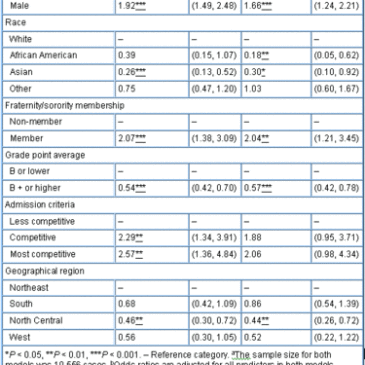People hold the belief that college students mostly use illegal drugs like ecstasy and marijuana. However, many college students also report misusing prescription drugs. Prescription drug misuse is a risk factor for the misuse of other drugs: college students who misuse prescription drugs are more likely to use marijuana, cocaine, and designer drugs, for example (Meilman & Crace, 1995). In addition, Low and Gendaszek (2002) found that about a third of college students use amphetamines without a prescription. Students misuse these stimulants for various reasons such as attempting to enhance academic or sports performance (Low and Gendaszek, 2002).
This week’s STASH reports on a study by McCabe, Knight, Teter, & Wechsler (2005) that examined prevalence rates and risk factors of non-medical use of prescription stimulants in college students. These researchers analyzed data from the 2001 College Alcohol Study (CAS), which surveyed college students from 119 four-year universities and colleges; the response rate was 52%; 10, 904 participants completed a questionnaire that included questions on the non-medical use of prescription stimulants (e.g., Ritalin, Dexedrine, and Adderall).
Participants also answered questions about illicit drug use, cigarette use, and alcohol use, as well as questions pertaining to other risky behaviors. In addition, the questionnaire included demographic items including grade point average and fraternity/ sorority membership.
The authors found that 6.9% of students reported non-medical use of prescription stimulants during their lifetime. Four percent (4.1%) reported use during the past year and 2.1% reported use during the past month. The authors performed a multivariate logistic regression to estimate the extent to which student characteristics contribute to the likelihood of non-medical use of stimulants after controlling for student and college characteristics. Table 1 summarizes the odds ratios of student and college characteristics and prescription stimulant use. Males, fraternity/ sorority members, and students at more competitive schools were more likely to misuse stimulants. White participants reported more non-medical use of stimulants than Africa-American and Asian students. Students with B+ or greater averages, and students in North Central states were less likely to be abusers. Students who were from universities and colleges from North-eastern region were more likely to report non-medical use of prescription drugs. In addition, non-medical use of stimulants was significantly related to drug use. Students who misused stimulants were more likely to report marijuana, ecstasy, opiates, and cocaine use in both the past month and past year.
Figure. Table 1. Correlates of non-medical use of prescription stimulants by student and college characteristics (a). Adapted from McCabe et al. Click image to enlarge.
Since the study aggregated students who were prescribed stimulants and students who weren’t prescribed stimulants, it did not take legitimate stimulant use into account. Therefore, it is difficult to determine the extent of misuse among the participants. These two groups of substance using students might have different patterns of risk factors and correlates. Since the data was based on self-reports, the actual prevalence rates of stimulant misuse might be higher or lower than reported. In addition, the response rate was marginal, suggesting that the data might not be representative. Further, the data is five years old and might not reflect current use patterns. Perhaps newer studies will demonstrate different findings.
Despite these concerns, the study’s findings illustrate the need for college administrations to address the misuse of prescription drugs. Colleges also need to provide resources for students who misuse these drugs and students who are at risk for such misuse. Since this study focused on the prevalence rates and correlates of non-medical use of stimulants, more current research is needed to examine students’ motivations for using and misusing stimulants. Future studies should assess coping styles and family environment as well. Hopefully current and future findings will aid college campuses to reduce both illegal drugs and illicit use of medical drugs.
What do you think? Please use the comment link below to provide feedback on this article.
References
Low, K.G., & Gendaszek, A.E. (2002). “Illicit use of psychostimulants among college students: a preliminary study.” Psychology, Health & Medicine 7(3): 283-287.
McCabe, E. S., Knight, J. R., Teter, C.J., & Wechsler, H. (2005). “Non-medical use of prescription stimulants among US college students: prevalence and correlates from a national survey.” Addiction 9: 96-106.
Meilman, P.W., & Crace, K. (1995). ” Beyond performance enhancement: Polypharmacy among collegiate users of steroids.” Journal of American College Health 44(3): 98-104.





